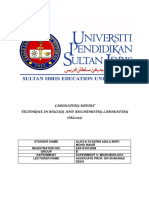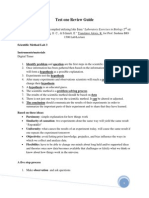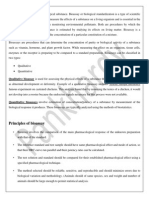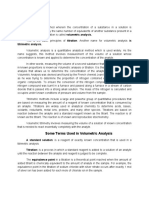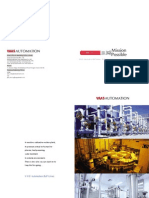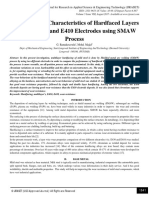Reflection sbl1023
Reflection sbl1023
Uploaded by
api-385038701Copyright:
Available Formats
Reflection sbl1023
Reflection sbl1023
Uploaded by
api-385038701Original Title
Copyright
Available Formats
Share this document
Did you find this document useful?
Is this content inappropriate?
Copyright:
Available Formats
Reflection sbl1023
Reflection sbl1023
Uploaded by
api-385038701Copyright:
Available Formats
REFLECTION OF TITRATION
The reflection from this experiment are the titration is a technique where a solution of known
concentration is used to determine the concentration of an unknown solution. Typically, the
titrant (the know solution) is added from a buret to a known quantity of the analyte (the
unknown solution) until the reaction is complete. Knowing the volume of titrant added allows
the determination of the concentration of the unknown. Often, an indicator is used to usually
signal the end of the reaction, the endpoint. Though equivalence point and endpoint are
used interchangeably, they are different terms. Equivalence point is the theoretical
completion of the reaction: the volume of added titrant at which the number of moles of
titrant is equal to the number of moles of analyte, or some multiple there of (as
in polyprotic acids). Endpoint is what actually measured, a physical change in the solution as
determined by an indicator or an instrument mentioned above. There is a slight difference
between the endpoint and the equivalence point of the titration. This error is referred to as an
indicator error, and it is indeterminate.
REFLECTION OF SPECTROPHOTOMETER (PROTEIN/ENZYME)
Reflectance spectroscopy is the study of light as a function of wavelength that has been
reflected or scattered from a solid, liquid, or gas. As photons enter a mineral, some are
reflected from grain surfaces, some pass through the grain, and some are absorbed. Those
photons that are reflected from grain surfaces or refracted through a particle are said to be
scattered. Scattered photons may encounter another grain or be scattered away from the
surface so they may be detected and measured. Transmission spectroscopy is highly
interrelated to Absorption Spectroscopy. This technique can be used for solid, liquid, and
gas sampling. Here, light is passed through the sample and compared to light that has not.
The resulting spectrum depends on the path length or sample thickness, the absorption
coefficient of the sample, the reflectivity of the sample, the angle of incidence, the
polarization of the incident radiation, and, for particulate matter, on particle size and
orientation.
REFLECTION OF LIPID ANALYSIS
The reflection from this experiment is we have found out the type of food that contains the
most amount of lipid in it by extracting the lipid content using petroleum ether. However, the
percent of lipid extraction in three sample of food is same though the sample have peanut
and milk. The important part in this experiment is to check there is no longer a strong smell
characteristics of the petroleum ether. Lastly, we know how to determine the percent lipid
extraction by use the formula given.
You might also like
- Pharmaceutics: Basic Principles and FormulationsFrom EverandPharmaceutics: Basic Principles and FormulationsRating: 3.5 out of 5 stars3.5/5 (6)
- 4 7E Land Breeze and Sea Breeze With Activity Sheet (March 26-27)Document13 pages4 7E Land Breeze and Sea Breeze With Activity Sheet (March 26-27)Jason Jay Rendon100% (4)
- Lab SolutionsDocument28 pagesLab SolutionsRaja Mohan Gopalakrishnan0% (1)
- Lab 5 Microbiology sbl1023Document9 pagesLab 5 Microbiology sbl1023api-385038701100% (1)
- Phys 181Document2 pagesPhys 181sophiecaiNo ratings yet
- Chris Beardsley - Strength Is SpecificDocument244 pagesChris Beardsley - Strength Is SpecificMarcelo Da Silva100% (5)
- (Martin Ferrier Young BSC (Hons Phys) BSC (Chiroprac (B-Ok - CC) PDFDocument271 pages(Martin Ferrier Young BSC (Hons Phys) BSC (Chiroprac (B-Ok - CC) PDFCristian TricaNo ratings yet
- Colorimetric MethodsDocument5 pagesColorimetric MethodsGraceNo ratings yet
- Bio-Chemistry Analyzer 6Document52 pagesBio-Chemistry Analyzer 6ramadhanrama4246No ratings yet
- Determination of The Equivalent Weight of An Unknown AcidDocument4 pagesDetermination of The Equivalent Weight of An Unknown AcidAlphonse SambranoNo ratings yet
- KJL Kjeldahl Method Lab ManualDocument6 pagesKJL Kjeldahl Method Lab ManualVanesha Anes0% (1)
- Res 2Document19 pagesRes 2Briana Doriane NebrejaNo ratings yet
- Enzymology LabDocument8 pagesEnzymology LabElif Naz SNo ratings yet
- Clinical Chemistry Key ConceptDocument13 pagesClinical Chemistry Key ConceptIbnul Islam AbdellahNo ratings yet
- Analytical Chemistry IDocument38 pagesAnalytical Chemistry IAbdulrahman100% (1)
- Preparation of Sample For AnalysisDocument27 pagesPreparation of Sample For Analysisapi-26215965100% (3)
- BIO-CHEMISTRY PresentationDocument52 pagesBIO-CHEMISTRY Presentationmohammed alolfeNo ratings yet
- Effect of Varying Concentration On AbsorbanceDocument5 pagesEffect of Varying Concentration On AbsorbanceAriel ChenNo ratings yet
- Enzyme Assay DifficultDocument5 pagesEnzyme Assay DifficultAtta SubhanNo ratings yet
- ColourimetricanalyisiDocument25 pagesColourimetricanalyisiSour GinNo ratings yet
- Analytical Techniques in Biotechnology: Lab Component Name: Saumya S Reg. No.: 15BBT0054 Date: Lab 6: Part 1-SolvatochromismDocument11 pagesAnalytical Techniques in Biotechnology: Lab Component Name: Saumya S Reg. No.: 15BBT0054 Date: Lab 6: Part 1-SolvatochromismSaumya SelvarajiNo ratings yet
- Enzyme Assay - WikipediaDocument8 pagesEnzyme Assay - WikipediashrutiNo ratings yet
- ReflectionDocument8 pagesReflectionapi-384770852No ratings yet
- Test One Review Guide: Scientific Method Lab 3Document8 pagesTest One Review Guide: Scientific Method Lab 3kalexis2233No ratings yet
- PHAYG062 - Preformulation: O, W o W O, W O, WDocument3 pagesPHAYG062 - Preformulation: O, W o W O, W O, Wchegu BusinessNo ratings yet
- Penentuan Kadar Protein Dalam Albumin Telur Melalui Metode LowryDocument7 pagesPenentuan Kadar Protein Dalam Albumin Telur Melalui Metode LowryKadek Anggra SupraptaNo ratings yet
- Glucose Cholesterol Measurement 070119Document17 pagesGlucose Cholesterol Measurement 070119rzazadeaysu90No ratings yet
- Analytical NotesDocument25 pagesAnalytical NotesRyan BoodramlallNo ratings yet
- Qualitative Analysis and Quantitative AnalysisDocument9 pagesQualitative Analysis and Quantitative AnalysisUmair UmairNo ratings yet
- New Expt 8 Spectroscopy Lab Chlorophyll With SpectroVisDocument12 pagesNew Expt 8 Spectroscopy Lab Chlorophyll With SpectroVisAdam Bryant PoonawalaNo ratings yet
- Enzyme AssaysDocument28 pagesEnzyme Assaysshamit big SAMNo ratings yet
- Enzyme AssayDocument6 pagesEnzyme AssayJaydeep Das100% (1)
- LABORATORY INSTRUMENTATION AND MEASURMENTS METHOD Lect3Document18 pagesLABORATORY INSTRUMENTATION AND MEASURMENTS METHOD Lect3Raed KananNo ratings yet
- Assignment 1 PADocument29 pagesAssignment 1 PAMahimaNo ratings yet
- Lab Report 1 (Handwritten)Document3 pagesLab Report 1 (Handwritten)Nurul NadiaNo ratings yet
- Preformulation NotesDocument19 pagesPreformulation NotesAnkit Arora67% (3)
- The Concept of Pre FormulationDocument11 pagesThe Concept of Pre FormulationGajendra GowdaNo ratings yet
- Principles of BioassayDocument17 pagesPrinciples of BioassayUmasankar KulandaiveluNo ratings yet
- BioassayDocument38 pagesBioassayMuhammad Masoom Akhtar100% (1)
- Enzyme Activity and AssaysDocument6 pagesEnzyme Activity and Assaysapi-318629889No ratings yet
- المحاضره الاولى PDFDocument5 pagesالمحاضره الاولى PDFقناص المدينهNo ratings yet
- UV ApplicationDocument24 pagesUV ApplicationPratik KulkarniNo ratings yet
- "If It Were Done... Then Twere Well It Were Done Quickly": Chemical KineticsDocument14 pages"If It Were Done... Then Twere Well It Were Done Quickly": Chemical KineticsWoshi WoNo ratings yet
- Lecture 7Document21 pagesLecture 7dineshkumaryadav39423No ratings yet
- Material and MethodDocument9 pagesMaterial and MethodRaouf NaikNo ratings yet
- Basic Terminology in TitrationDocument18 pagesBasic Terminology in TitrationFrancis RebancosNo ratings yet
- Practical 2Document26 pagesPractical 2vs322794No ratings yet
- Determining The Concentration of Protein On Egg Albumin Through Lowry MethodDocument6 pagesDetermining The Concentration of Protein On Egg Albumin Through Lowry MethodMuslimah Anggun100% (5)
- المحاضرة الاولىDocument5 pagesالمحاضرة الاولىقناص المدينهNo ratings yet
- Lab - ManualDocument8 pagesLab - ManualaksndlaknNo ratings yet
- Lab 05 ReportDocument8 pagesLab 05 ReportbkohlNo ratings yet
- Volumetry: Titrimetric AnalysisDocument6 pagesVolumetry: Titrimetric AnalysisBen AbellaNo ratings yet
- Quality Control Lab Manual AnswersDocument6 pagesQuality Control Lab Manual Answerskriss WongNo ratings yet
- Pre Formulation StudyDocument49 pagesPre Formulation StudyShaimaa AlsamarraiNo ratings yet
- Visible SpectrophotometricDocument24 pagesVisible SpectrophotometricArsel100% (1)
- Colorimetry EssayDocument4 pagesColorimetry EssaylujaynaxxNo ratings yet
- Centrifugation 2022 3Document25 pagesCentrifugation 2022 3Paramveer SinghNo ratings yet
- Molecular Absorption SpectrometryDocument32 pagesMolecular Absorption SpectrometryKakkaNo ratings yet
- Bioassay FinalDocument27 pagesBioassay FinalAbhijeet MihirNo ratings yet
- Immunoassay TheoryDocument22 pagesImmunoassay TheoryFAWKESKNo ratings yet
- AP Lab 4 PhotosynthesisDocument6 pagesAP Lab 4 PhotosynthesisJack LiuNo ratings yet
- Lab 13 Enzymes Reading PDFDocument8 pagesLab 13 Enzymes Reading PDFLarryDengNo ratings yet
- Fluorescence Spectrophotometry of Riboflavin - OdinityDocument4 pagesFluorescence Spectrophotometry of Riboflavin - OdinityKariEspinozaNo ratings yet
- A Comprehensive Book on Experimental PharmaceuticsFrom EverandA Comprehensive Book on Experimental PharmaceuticsRating: 5 out of 5 stars5/5 (1)
- Lab 6 sbl1023Document7 pagesLab 6 sbl1023api-385038701No ratings yet
- Lab Report 4 sbl1023Document7 pagesLab Report 4 sbl1023api-3850387010% (1)
- Lab Report 3 sbl1023Document5 pagesLab Report 3 sbl1023api-385038701No ratings yet
- Lab 2 Titration sbl1023Document10 pagesLab 2 Titration sbl1023api-385038701No ratings yet
- Gen Math First Quarter ExaminationDocument2 pagesGen Math First Quarter ExaminationJoylass Pasac100% (1)
- Le Nouveau Taxi! 1Document32 pagesLe Nouveau Taxi! 1Jay Rắc RốiNo ratings yet
- Coaster Creator Post LabDocument5 pagesCoaster Creator Post Labapi-2370502570% (2)
- MLR Session 2 Exercises LEFM PDFDocument31 pagesMLR Session 2 Exercises LEFM PDFYessenia Huachaca CasquinaNo ratings yet
- Atomic Nuclei (Grade 11)Document33 pagesAtomic Nuclei (Grade 11)AR BE ENNo ratings yet
- Narrative Report ChemDocument2 pagesNarrative Report ChemCarlle Lerwick100% (1)
- 03 - Iron - Iron CarbideDocument35 pages03 - Iron - Iron CarbidebotobotoakbarNo ratings yet
- Pressure Vessel Handbook Ninth Edition 1992 PDFDocument481 pagesPressure Vessel Handbook Ninth Edition 1992 PDFjudico60_70175733No ratings yet
- Determining and Calculating PHDocument33 pagesDetermining and Calculating PHshigateNo ratings yet
- VAAS General CatalogueDocument14 pagesVAAS General CataloguenaughtyguymNo ratings yet
- Aws Publications Catalog: Summer 2010Document20 pagesAws Publications Catalog: Summer 2010saeedahmad901No ratings yet
- Aubrey Dunne 2009 Thesis FinalDocument210 pagesAubrey Dunne 2009 Thesis FinalShan XuNo ratings yet
- Hm15009e PDFDocument8 pagesHm15009e PDFYoni EhmNo ratings yet
- Study of Wear Characteristics of Hardfaced Layers Made by E430 and E410 Electrodes Using SMAW ProcessDocument8 pagesStudy of Wear Characteristics of Hardfaced Layers Made by E430 and E410 Electrodes Using SMAW ProcessIJRASETPublicationsNo ratings yet
- Photoevaporation of Molecular Clouds in Regions of Massive Star Formation as Revealed Through H2 and Brγ EmissionDocument19 pagesPhotoevaporation of Molecular Clouds in Regions of Massive Star Formation as Revealed Through H2 and Brγ EmissionFábio DuarteNo ratings yet
- All About Space - Book of The Solar System PDFDocument164 pagesAll About Space - Book of The Solar System PDFVishnu100% (1)
- RR 105Document130 pagesRR 105Dr R Panneer SelvamNo ratings yet
- Dissolution Calibration NetDocument7 pagesDissolution Calibration Net0921pyNo ratings yet
- MATH 141 Webworks .Set1Document2 pagesMATH 141 Webworks .Set1razanmk961214No ratings yet
- Op-029. Interpretation of Ciu Test: Work Instructions For EngineersDocument7 pagesOp-029. Interpretation of Ciu Test: Work Instructions For EngineersNadeem AbbasiNo ratings yet
- 4 - PRO - Alpha 355 - ENDocument6 pages4 - PRO - Alpha 355 - ENGuillermo Betancourt100% (1)
- Ebook Engineering Dynamic Mechanical Thermal AnalysisDocument93 pagesEbook Engineering Dynamic Mechanical Thermal AnalysisBüşra Şahin100% (1)
- Thermal InsulationDocument60 pagesThermal InsulationSpyros IliakisNo ratings yet
- AP Chapter 5 - GasesDocument2 pagesAP Chapter 5 - GasesAnaliaMertinezNo ratings yet
- Guy Strain InsulatorDocument2 pagesGuy Strain InsulatorPasupuleti007No ratings yet
- Doosan DX55 Midi ExcavatorDocument3 pagesDoosan DX55 Midi ExcavatorDidik HartadiNo ratings yet



